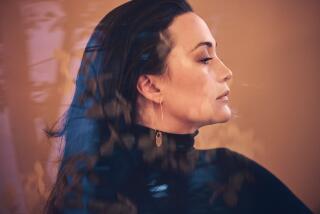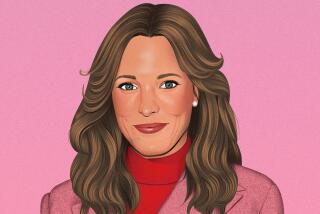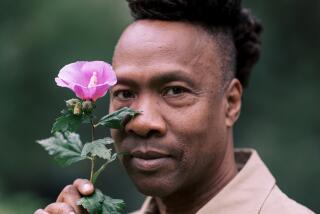With ‘Mudbound’ and ‘Black Panther,’ Oscar-nominated cinematographer Rachel Morrison has already made history

A mere two months in, and it’s already been a career-boosting, history-making year for cinematographer Rachel Morrison.
In January, she became the first woman ever nominated for a cinematography Oscar for her work on Dee Rees’ 1940s-set period drama, “Mudbound.”
In February, her ability to bring Ryan Coogler’s kinetic vision of Wakanda to life in the box office smash “Black Panther” made her the first woman to shoot a movie in the Marvel Cinematic Universe.
And on March 4, she will vie for a groundbreaking laurel at the 90th Academy Awards.
Has it all sunk in yet?
“Not really,” laughed Morrison, 39, between breaks in filming on a commercial shoot, in the midst of a hectic pre-Oscars week. “I’m also a mom, so what little time I have when I’m not working goes to my three year-old son and not to the processing that I probably should be doing.”
For the Massachusetts-born but Los Angeles-based cinematographer, it’s been a surreal journey with “Mudbound,” Rees’ $10-million indie drama about two families — one black, one white — trying to survive in the unforgiving Mississippi Delta amid the traumas of war and bigotry.
Directors of photography aren’t generally used to the spotlight, she joked. Since Netflix erected billboards celebrating “Mudbound” and its four Oscar nominations — emblazoned with Morrison’s likeness — all over Los Angeles, the attention has been “a little bananas.”
“It’s crazy, I didn’t even know,” she said. “It wasn’t like Netflix said, ‘We’re going to put your face on a billboard.’ I just got a text from a friend and I was like, What is going on? It must be like winning the lottery.”
Morrison filmed “Mudbound” two years ago after wrapping HBO’s “Confirmation.” She was supposed to head to the Louisiana production of “Mudbound,” which is adapted from the Hillary Jordan novel, in January.
But delays pushed production to the grueling southern summer, which added enormous challenges — and copious amounts of the titular mud — with its unpredictable bursts of rainstorms.
“We were shooting very long, very packed days — in fields with no cover from the sun for most of the day,” recalled Rees via email, “and then suddenly racing the sun across the sky in the evening. One of the many things I really appreciated about having Rachel as a collaborator was her relentlessness and her tirelessness. She never sat down, she never took a break, she never gave up. She’s a great leader of her camera crew and is always searching for the better shot. She never settles.”
Rees is nominated for best adapted screenplay, along with Virgil Williams; Mary J. Blige for best supporting actress and best original song, along with Raphael Saadiq and Taura Stinson.
Inspired by period photography from the Farm Security Administration, Morrison shot digitally on the Alexa Mini with vintage anamorphic lenses to achieve a filmic look. Her photography brings the elements, the earth and the environment around Rees’ cast to life in vivid textures, building intimate emotion into every frame.
“I liked Rachel’s references — she talked about the old WPA photographers including Dorothea Lange and brought in reference photos that felt very alive and candid,” said Rees, referring to the New Deal-era Works Progress Administration. “She’s a very humanistic photographer, which I love, and I admired the candor and ‘breath’ she brings to her subjects.”
“People — thankfully — are surprised that we didn’t shoot on film because it looks like it originated on film, and as much as I wanted it to originate on film and it felt sacrilegious that we didn’t shoot on film, I’m proud of what we accomplished digitally,” said Morrison, who also served as camera operator on the 29-day shoot.
“It’s been extremely fulfilling,” she said of the “Mudbound” experience. “I’m just incredibly grateful that the movie not only got seen – which in this day and age, you can’t even guarantee – but was also as well received as it was, not just for myself but for the crew. That was a movie that took every single crew member’s blood, sweat and tears to make come together.”
She barely had a moment to rest between “Mudbound” and her work on “Black Panther” with Coogler. The two already shared a close director-DP shorthand after collaborating on Coogler’s acclaimed feature debut “Fruitvale Station” just five years ago, which starred Michael B. Jordan, also of “Panther.”
“We’re like family now, and on any film, but certainly one as long as a Marvel film, you end up playing the role of sister and psychologist, I try to be there for him emotionally and vice versa. We’re just close as human beings and not just filmmakers,” said Morrison.
“I think that even on a bigger film, our instincts haven’t changed that much. Ryan tends to like handheld and experiential single-camera coverage and tight eye-lines, things that just feel right to him in any movie and that transcend the story itself, almost. Ryan’s also incredibly collaborative. He really loves to hear everybody’s opinions, which I think is part of what really inspires the people around him to tune in and give him their best work.”
Still, Morrison admits that going from the indie world to the Marvel Cinematic Universe was intimidating at first, given the heavy visual effects and action work “Black Panther” required. “But I pretty quickly realized that it was in large part just common sense and that VFX isn’t magic — it’s actually logic,” she said. “Once I got past the initial intimidation factor, I settled in pretty easily.”
Lensing a production as ambitious and sprawling as “Black Panther” brought new challenges — and a much larger crew to wrangle. “You’re managing multiple sets being built and designed and prelit at the same time, there was a second unit crew, there was a splinter crew, there was a rigging crew – it’s much, much bigger in terms of the moving parts,” she said.
The part of the job she missed most? Operating her own camera. “The biggest difference for me was that I operated almost every frame on ‘Mudbound’ and I didn’t operate on ‘Black Panther,’” she said. “When you’re so used to operating the camera, it’s an extension of your eye and your heart and your head. But even then, I learned to let go, and I had Scott Sakamoto who is one of the masters of camera operating as my camera operator so I knew it was in good hands.“
FULL COVERAGE: ‘Black Panther’ »
Being thrust into the Oscar spotlight while scaling up to her first $200-million production has now placed Morrison in the company of many of her cinematography idols, veterans who she says have welcomed her into the ranks.
At this year’s American Society of Cinematographers awards, she was nominated for the top honors along with Roger Deakins ( who won for “Blade Runner 2049”), Bruno Delbonnel (“Darkest Hour”), Hoyte van Hoytema (“Dunkirk”) and Dan Lausten (“The Shape of Water”) — the same quartet of cinematographers she’s up against at the Academy Awards.
“Hoyte and I have become friends, which is one of the highlights to come out of this — now I get to hang out with Hoyte van Hoytema!” she said. “Bruno and I knew each other a little bit; I approached him ten years ago when I had a student film at Camera Image and he was there with a feature, and he had shot ‘Amelie,’ which is one of my favorite films — we loosely stayed in touch over those ten years, so it was nice to be sitting next to him as a peer.
“The highlight from ‘Mudbound’ was a personalized email from [Oscar-nominated ‘French Connection’ cinematographer] Owen Roizman, who I think is so special. I’d gotten one from Haskell Wexler after ‘Fruitvale,’ and those are the kinds of things, when people that you look up to in your career take the time to write to you — they’re all the pats on the back you could possibly ask for.”
With a background in photography, it was the intangible emotionality of the craft that pulled her toward cinematography as a teenager — the magic she found in cinema, in the moving image.
“It was realizing that I would come out of movies incredibly moved,” Morrison said. “I would cry, I would laugh, I would feel like a changed person as a result of the film I had seen. And as much as the static image resonated with me and left an indelible impression, it didn’t make me emote in the same way. I think I realized there was a power to the moving image that I couldn’t equal in still photography.”
She credits her early work on documentary projects as a fertile training ground for the intimate work she does now in narrative storytelling.
“Documentaries are inherently instinctual; you’re constantly moment to moment, determining what the best place for the camera is to tell the story, usually in service of natural lighting.I feel like my whole career has been basically trying to emulate that natural light with film light. I got to understand how light works, from years of not lighting.”
“Usually if you notice good cinematography, then the cinematographer’s failing,” she laughed. “I try to make light feel like it’s always motivated and natural in some way and hope that the lighting goes unnoticed.”
Even her 2008 stint as director of photography on reality series “The Hills” — “I needed to pay off my student loans!” she explained — imparted her with valuable lessons at a time when digital filmmaking was revolutionizing the way TV was made. Camera and lighting equipment were getting cheaper and more efficient, and new-school methods were arming younger DPs with different ways of working.
“What I inadvertently realized was that it was actually a great training ground because I was lighting for three cameras at a time when suddenly digital became an option and cameras became cheap, and almost all productions started to shoot multi-camera,” said Morrison.
“So I had this skill set that I didn’t realize would come in as handy as it did, which was lighting for multiple cameras at the same time, and also lighting with units you could plug into the wall at 1200 watts or less.
“That’s the thing that took all the older more seasoned DPs and kind of knocked them off their high horses for a beat, because they were all so used to arc lights and 18Ks, and suddenly you had productions that were making a movie that looked similar with smaller units.”
She paused. “Without meaning to, ‘The Hills’ actually prepared me really nicely for independent cinema.”

Perhaps just as importantly, the experience also helped solidify Morrison’s dedication to telling certain kinds of stories. “It definitely cemented my belief that I wanted to tell stories that had consciousness behind them, and had social messaging and allowed people to experience lives… that basically weren’t all about entitled white people,” said Morrison, whose credits include “Sound of My Voice,” “Little Accidents,” “Some Girl(s)” and “Cake.”
She may not quite be comfortable with the attention her historic Oscar nomination has brought to her doorstep, but seeing how much the achievement means to many others — not just to aspiring female cinematographers but to the veteran male DPs who continue to dominate the field — has been “incredibly eye-opening.”
“I can’t tell you how many ASC members came up to me and said, ‘We’re just so thrilled for you,’ and ‘I’m just so happy I got to see this in my lifetime.’ That’s been really incredible,” said Morrison. “I think there’s almost an assumption that there’s a resistance on the other side, but that’s been really refreshing to realize.”
Hearing the next generation of female DPs express how much it means to them to see her recognized reminds her of the women who paved the way for her — cinematographers like Ellen Kuras (“Eternal Sunshine of the Spotless Mind”), Mandy Walker (“Hidden Figures”), Maryse Alberti (“The Wrestler”), Nancy Schreiber (“Your Friends & Neighbors”), Amy Vincent (“Hustle & Flow”) and Sandi Sissel (“The People Under the Stairs”).
“But,” Morrison added, “I could count that number on one or two hands. It is a little bit like when you’re so used to things being how they are, it becomes a grind because you can’t picture things changing. And if this is symbolic of change, then maybe that’s enough to keep people excited and coming back for more.”
ALSO
Natalie Portman, Gina Rodriguez, Tessa Thompson and the sci-fi sisterhood behind ‘Annihilation’
How Chadwick Boseman brought power and purpose to Marvel’s ‘Black Panther’
More to Read
Only good movies
Get the Indie Focus newsletter, Mark Olsen's weekly guide to the world of cinema.
You may occasionally receive promotional content from the Los Angeles Times.







